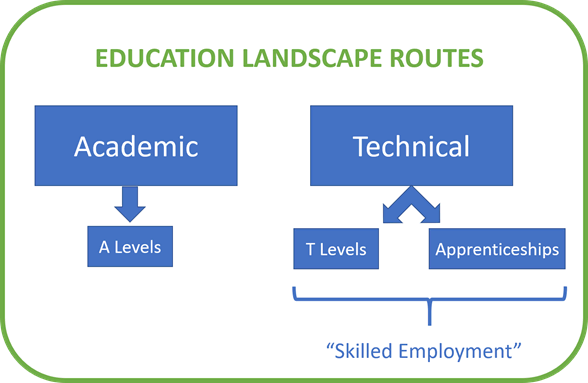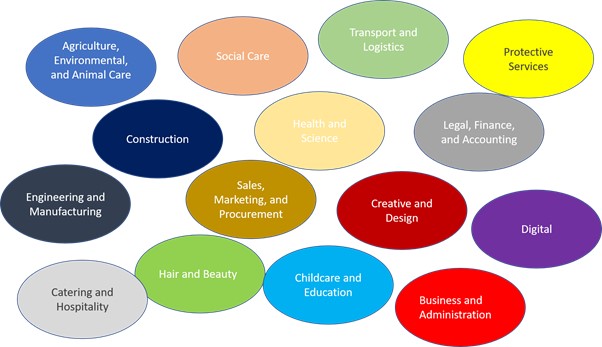T Levels – Back To The Future At 16

The Need for a Brand New Qualification
 So, what’s wrong with the current education system in the UK? And why are T levels the missing ingredient that will fix this?
So, what’s wrong with the current education system in the UK? And why are T levels the missing ingredient that will fix this?
Well, it’s easier to answer the first of those questions than the second. But here goes.
Firstly, this is what our current system doesn’t provide:
- a well-understood, national system of qualifications that are genuinely respected by employers and so have value for the individual in the labour market
- widespread availability of comprehensive and consistent career guidance — including accurate and up-to-date labour market information and institutional performance data — so that all individuals can make informed choices between the education and training options on offer
- stable institutions with appropriate infrastructure for the delivery of technical education, including high-quality teaching and access to industry-standard facilities and equipment
- a system of adequate funding that incentivises individuals and employers to participate in education and training which results in productivity gains
So, this is what is now being recommended by the Government to address these shortcomings:
“Our proposed reforms will simplify the system, offering post-16 students the choice between a technical and an academic option. The technical option will be made up of 15 clear routes leading to skilled employment which requires technical knowledge and practical skills valued by industry. Panels of professionals will take the lead in setting the standards for each route to ensure that they deliver the skills needed by the economy, helping low-skilled workers to progress to the intermediate- and higher-level skilled positions that drive productivity, and minimising the number of people entering the labour market without useful skills and qualifications.”
T levels will be brand new qualifications, which will be introduced in phases between 2018 and 2020 with the goal of becoming the qualification of choice associated with the highest level of skilled employment in the UK.
The intention is that British industry will no longer be reliant on importing skilled workers from overseas in the post-Brexit era but can match the skill requirement of industry by developing homegrown talent.
The Treasury outlines its aim as: “when young people leave college they have the skills, knowledge and expertise employers want”. So, employers must play a big part in this story.
T levels will be the standard bearer for a world class technical education system as A levels are for academic prowess and the Department of Education has made the crucial pledge that T levels will be ‘on a par’ with A levels.
The change has been described by the Government as the “biggest overhaul of the post-school education system in 70 years”. That leads us to a …..
Brief History Lesson of UK Education
In 1944 the Atlee Government introduced the tripartite education system:
- Grammar,
- Technical and
- Secondary schools
The technical schools never really took off and by the sixties we were left with two strands of education, grammars and secondary.
The grammar school ‘academic’ journey involved collecting O levels then A levels possibly on the way to a university education where the focus was on acquisition of knowledge. Less than 5% of the population of a school year went to university in those days.
The secondary school route picked up a diluted version of O levels, the CSEs; few people taking this road went on to higher education, the majority joining the workforce at 16. Those ‘less academic’ students who took the ‘vocational’ route did so via short courses such as Diplomas at local FE Colleges and Polytechnics.
Which route you took, and your whole life outcome, was decided at 11 by the 11-plus exam. This became seen not only as far too drastic, but also as unfair. One ‘bad day at the office’ when you are 11 years old could have a hugely negative impact for the rest of your life!
Although it was Shirley Williams, then Education Secretary under Jim Callaghan’s Labour government, of course, who brought in Comprehensives, it was Lord Young who recently reminded me that the real revolution happened under Mrs T’s reign, when the grammar schools and secondary moderns were gradually phased out.
It was Young who answered Keith Joseph’s question, when Joseph was Thatcher’s Education Secretary: “what are we going to do with the bottom 40% who are bored, bored, bored by school, and will leave with nothing, or nothing worth mentioning?”
Already, the era of comprehensives, where the movement of talent between streams was supposed to be more fluid and fair rather than arbitrary and fixed at age 11, was not felt to be working.
“We must motivate them by offering a first class technical route”, said Young.
Both he and Kenneth Baker then went on to try to revive the missing 3rd technical leg of the post-war tripartite system.
To deal with the perception of Polytechnics as ‘second class’, they rebadged the ‘polys’ as ‘unis’, paving the way to the proliferation of a university education for all.
While A levels remained a rock solid route in, there was an explosion of courses, from HNDs to NVQs, all trying to meet the technical void, but adding chaos and confusion for young people as well as employers, not knowing what they were worth.
The New Education Landscape
So, the proposed post-16 education landscape will be split into two routes, one being the academic path, destination university, and the other will be a journey to skilled employment, either through an apprenticeship or T levels.
To clarify, Apprenticeships are ‘work-based’, that is work supported by study, and T levels are ‘provider-based’, study supported by work placement.

Interestingly, it’s evolved and revolved full circle to Atlee’s original tripartite plan.
An Alternative Route

In this age of high student debt and reduced job prospects for graduates, the T levels will be designed to offer an alternative path into the jobs market from university. Although, the T level qualification should be the equivalent of 3 A levels, the emphasis will be on making the participants ‘workfit’.
In principle this sounds great, but didn’t they say this about BTECs and CSEs before them?
The jewel in the crown is the promise of a “high-quality, structured work placement”; 900 hours of teaching supported by 3 months working for an employer in an industry aligned to the course, so that the theory learned in the classroom over two years can be blended with applied knowledge from the relevant skills being put into practice in the work environment. Perfect.
This also has the added ingredient of social mobility as teenagers from less privileged backgrounds are gaining the all-important work opportunities and associated employability factor, alongside a real chance to progress in a good career that will have the prospect of earning them a better living than their parents. Social justice in action.
Consolidation of the Qualifications Industry
The new T levels will represent a consolidation of the vocational qualification industry and is a reflection of where governments of the past have struggled with this area.
The mere 15 new courses aimed at broad industry sectors (see illustration below) through occupational mapping will replace the 13,000 (unbelievably!) other ‘vocational’ qualifications currently on offer, which Philip Hammond has been quoted as describing as ‘many of them (are) of little value’. Ouch!
The number of qualifications had proliferated in an attempt to meet the ‘consumer’ style needs of the participants but the resultant unintelligible smorgasboard presents a confusing morass for the employers who struggle to compare the qualifications like for like, which sort of renders them meaningless.
The slimline 15 T level course categories:

Under Starter’s orders
Sensibly the Government is starting with the three sectors which should have high demand and a high chance of succeeding:
- Digital
- Construction
- Education and Childcare.
The rest will follow. Rather than go to university on course ‘x’ which the school or college has consciously or subconsciously pushed the student towards, deferring the agonising decision of what to do with their life for another tantalising 3 years, young people can begin to focus on a career of choice early doors.
Neil Wolstenholme, Chairman, Kloodle
Three-part series
The skills-productivity gap; the purpose of education; culture change; and large sums of public money. Serious stuff. So, in theory, it all seems to stack up. But will it work? Read Part 1 “T Levels: What do Mr T and Mrs T Have In Common? ” now and Read Part 3, next Tuesday, to find out.
Copyright © 2018 FE News
If you are interested to find out more about how Kloodle can help you with a T level solution then please email Andrew Donnelly.











Responses